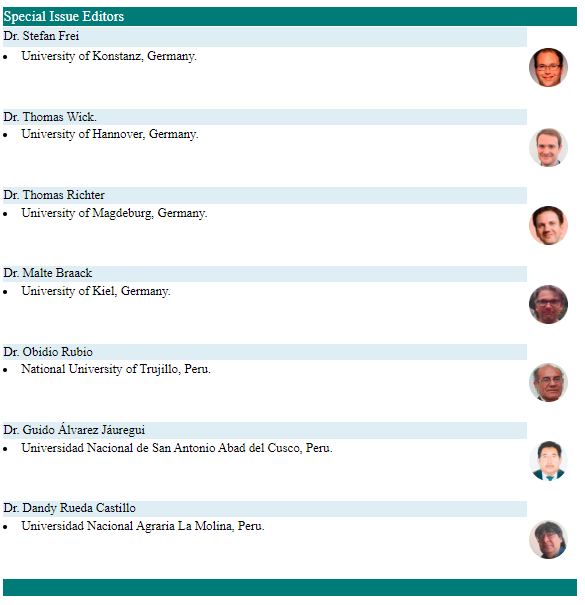On the numerical solution of a mathematical model for the concrete carbonation with a non-uniform diffusivity coefficient
DOI:
https://doi.org/10.17268/sel.mat.2021.02.01Palavras-chave:
concrete carbonation, reaction-diffusion problem, finite difference method, volume finite method.Resumo
In this research, a mathematical model to determine the concentration of concrete carbonation is investigated using several numerical schemes which provide the distribution of carbonation in a concrete region.
This model considers an Arrhenius-type relation which implies a non-uniform diffusion coefficient for a
reaction- diffusion problem in the model. To perform the computations of the model investigated, the finitedifferences and finite-volume methods are employed which are implemented in the mathematical software GNU-Octave and the finite-volume software OpenFOAM respectively.
Referências
Burden R, Faires J. Numerical Analysis, 3rd. ed., Brooks/Cole, 2012.
Dantzig JA, Tucker C. Modeling in Materials Processing, 1st ed., Cambridge University Press, 2001.
Evans JD, Fernández A. Sharp-Interface Models for Concrete Carbonation. Numerical Analysis and Applied Mathematics ICNAAM, AIP American Institute of Physics, 2012.
Eaton J, Bateman D, Hauberg S,Wehbring R. GNU Octave version 5.2.0 manual: a high-level interactive language for numerical computations. 2020.
Evans JD, Fernández A, Muntean A. Single and two-scale sharp-interface models for concrete carbonation - Asymptotics and numerical approximation Multiscale Model. Simul. SIAM, 2012; 10(3):874-905.
Leveque RJ. Finite Difference Methods for Ordinary and Partial Differential Equation, 1st ed., Society for Industrial and Applied Mathematics (SIAM), 2007.
Leveque RJ. Finite Volume Methods for Hyperbolic Problems, Cambridge University Press, 2002.
Li D, Li LY, Wang X. Mathematical modelling of concrete carbonation with moving boundary. International Communications in Heat and Mass Transfer, 2020; 117: 104809.
Ming-Te L, Shieng-Min L. Mathematical Modeling and Applications for concrete carbonation. Journal of Marine Science and Technology. 2003; 11:20-33.
OpenFOAM foundation. OpenFOAM - Field Operation and Manipulation. 3rd edition, Elsevier Science, 2012.
Papadakis VG, Vayenas CG, Fardis MN. Fundamental Modeling and Experimental Investigation of Concrete Carbonation, ACI Materials J. 1991; 88(4):363-373.
Pletcher R. Computational Fluid Mechanics and Heat Transfer, 3th. edition, CRC. Press; 1997.
Steffens A, Dinkler D, Ahrens H. Modeling carbonation for corrosion risk prediction of concrete structures Cement and Concrete Research, Pergamon. 2002; 32:935-941.
Downloads
Publicado
Como Citar
Edição
Seção
Licença
Copyright (c) 2021 Selecciones Matemáticas

Este trabalho está licenciado sob uma licença Creative Commons Attribution 4.0 International License.
Os autores que publicam nesta revista aceitam as seguintes condições:
Os autores mantêm os direitos autorais e atribuem à revista o direito da primeira publicação, com o trabalho registrado com a licença de atribuição Creative Commons Atribución 4.0 Internacional (CC BY 4.0), que permite que terceiros usem o material publicado sempre que mencionarem a autoria do trabalho e os direitos autorais. Primeira publicação nesta revista.
Os autores podem fazer outros acordos contratuais independentes e adicionais para a distribuição não exclusiva da versão do artigo publicada nesta revista (por exemplo, incluí-la em um repositório institucional ou publicá-la em um livro), desde que afirme claramente que o trabalho Foi publicado nesta revista.
É permitido e recomendado aos autores que publiquem seus trabalhos na Internet (por exemplo, em páginas institucionais ou pessoais) antes e durante o processo de revisão e publicação, pois isso pode levar a trocas produtivas e a uma disseminação maior e mais rápida do trabalho. publicado (Consultar: efeito do acesso aberto).












